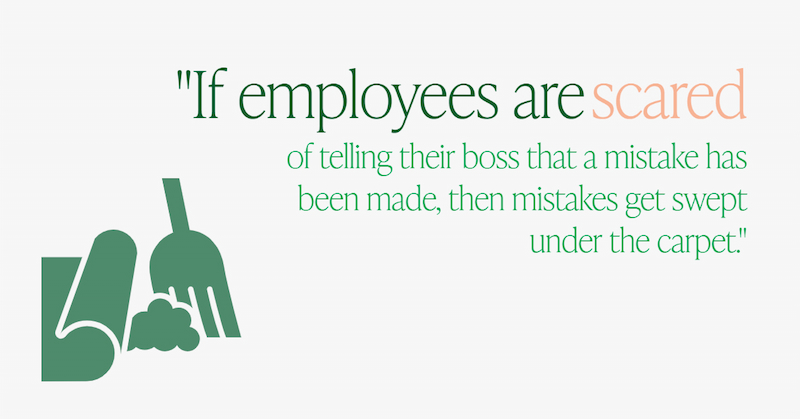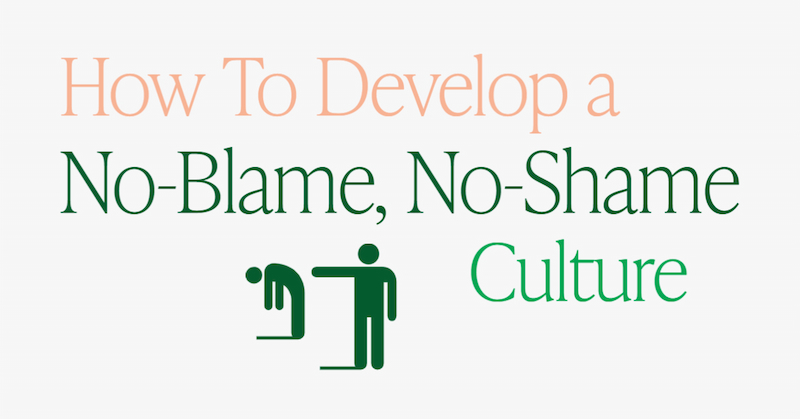As any health and safety officer knows too well, great insights need great data.
But great data isn’t always easy to obtain. Great data needs great reporting, and great reporting needs a culture that supports people speaking up. If mistakes lead to the blame game, where fingers are pointed, rumours whispered behind backs, and snide judgement passed, reporting the crucial numbers simply won’t happen.
Behind each data-driven report, there are far-reaching cultural foundations that shape which numbers get seen and heard, and which fall by the wayside.
The culture - the nuts and bolts of how things are done in any given organisation - can either support reporting mistakes made and near-misses, or it can repress this kind of acknowledgement.
What health and safety leaders must strive to create is what’s been dubbed a ‘no blame, no shame’ culture which empowers people to share every piece of information that might help facilitate greater safety insights.
Get fresh H&S insights weekly
What’s a no-blame, no shame culture?
This culture type evolved in high responsibility cultures - think airlines, hospitals or submarines - where employees were encouraged to identify any type of error, mistake or potential error and mistake immediately because the organisation operated in a high-risk industry. Given that mistakes in these industries are dangerous with a high risk of major consequences, employees need to feel like they can speak up about anything that looks wrong - without fear of retribution.
Not only does this culture create better data for reporting purposes, but it also helps ensure that all safety processes are transparent - where visible adjustments or improvements can be attributed to particular incidents or issues that have been reported.
This culture also helps interpersonal relations within the organisation and improves individual experiences of work. If people engage in gossip, denial, or persistent blame, trust between friends can be damaged and valuable relationships can be wrecked.
Now, more and more organisations are considering how they might implement such a culture. Even if the industry is lower risk than the aforementioned ones, there are huge benefits to creating a transparent culture that celebrates open, two-way communication.
Do you have a high-blame, high-shame culture?
Primarily, you’ll be suffering from a lack of data and scattered reports with unhelpful insights. When it comes to the meetings where the health and safety leader wants more support from the upper management, the reports they’ve put together offer little reassurance for the number-crunchers.
On a wider scale, pertinent issues such a high labour turnover that often points a finger to a toxic workplace culture where heavy gossip feeds a rampant rumour mill, are a sure sign of a high-blame, high shame culture.
In the event of an injury or accident, is the subsequent investigation seamless? If words such as accountability and responsibility cause people to turn on each other, and try to hand the reins to each other, there could be a high-blame, high-shame culture lurking. Furthermore, if denial seeps into conversations and
At the end of the day, this culture leads to holistic system failures which are often the underlying cause of injuries, incidents, or near-misses.
How do these negative cultures manifest?
In the spirit of discussing blame, there’s often no one reason or person that’s responsible for these cultures.
Things as nuanced as cultural differences might affect people. Some cultures punish whistleblowers and people are encouraged to avoid rocking the boat.
Some organisations need improved leadership from the top, where leaders encourage open discussion about mistakes made, with a nurturing approach. If employees are scared of telling their boss that a mistake has been made, then mistakes get swept under the carpet. Employees are discouraged from making suggestions or actively participating in the development of their own safety, and prefer to sit back.

What does a no-blame, no-shame culture typically look like?
Any cultural transformation is an arduous process, as we collectively tend to struggle with change. Organisational culture is fraught with obstacles and challenges, and changes won’t happen overnight.
Certainly, when people encounter stress, common reactions often include defensiveness, especially if they perceive that they’re being blamed for an issue. By creating a culture where transparency and an acceptance that mistakes can and will happen, the need to be defensive when confronted about a situation can be reduced.
Focus on developing a culture that celebrates and even rewards people for complete reporting of near-misses, issues, minor injuries and other key data points. Reports should become celebrated, rather than a point of contention for employees. Some experts even suggest giving out tangible incentives for complete reporting, such as gift vouchers or shouting lunch.
Ensure that the blame game is dropped. Start from the top-down, and get leaders and managers to share their own stories of mistakes made which lead to near-miss situations or even minor injuries. In doing so, you can create greater trust between team members and show what taking responsibility for an issue looks like. Workers will look to their leaders to model what’s acceptable and what isn’t at the office or worksite.
Continuous safety improvement needs good quality data to drive analytics and reports. This truly starts at the worker level, with people who are engaged in their safety system and have the right tools to engage with ease.
Final words
Often, safety begins with office culture and the immediate workplace environment that any person spends their time in, day to day.
Whether there’s a persistent blame game that stems from upper management, or there’s simply a degree of ignorance about which attitudes are really circulating when it comes to safety reporting, a high-blame, high-shame culture hurts everyone.
We need to address these subtle, but far-reaching blind spots so we can shift cultural perceptions of safety reporting and make the workplace a place that celebrates learning from mistakes. If we can take this approach and incentivise reporting and reward detailed accounts of any type of incident, we benefit from excellent data.




.png?width=352&name=Copy%20of%20RETAIL%20SAFETY%20(2).png)

.jpg?width=352&name=AI%20health%20and%20safety-1%20(1).jpg)


